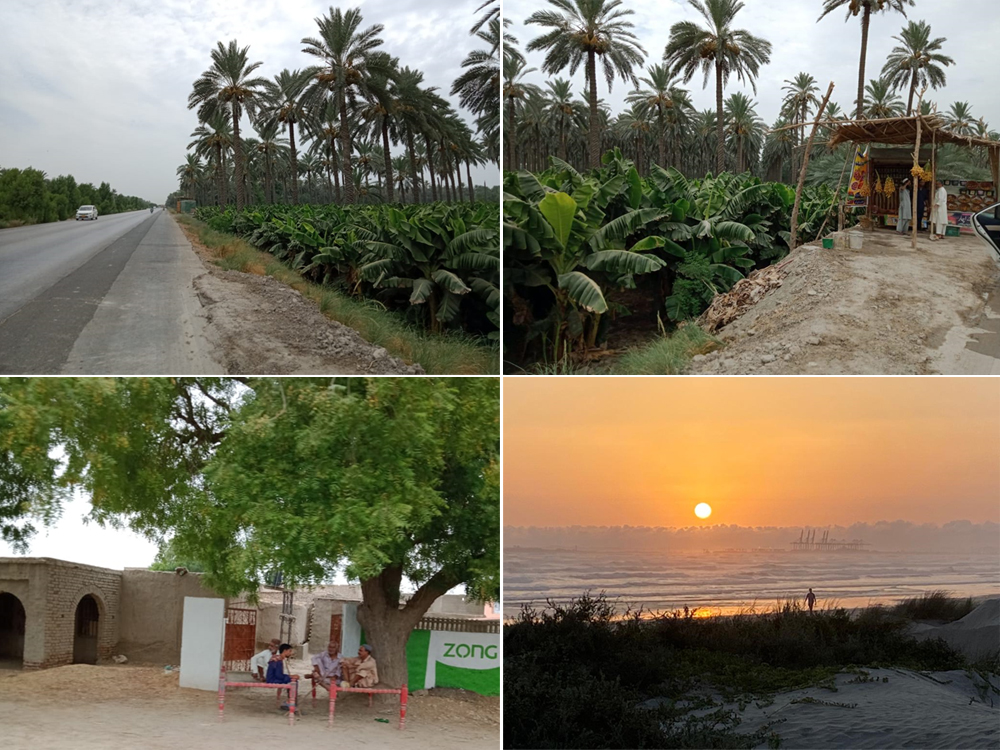The Sohagan and Dohagan Tombs Enroute to Date Palm Groves and Banana Plantations
Durriyah Balkhi Asghar CPA, Class of '91, is a Tax and Financial Consultant. She began her career with PriceWaterhouse, New York and is currently on a sabbatical.
Shameelah Balkhi (her sister) has an MS in Molecular, Cellular and Developmental Biology from Yale University and is currently a homemaker.
It was sizzling hot with temperatures in the forties, but it was an exciting time for us. It was our first road trip from Islamabad all the way to Karachi.
We drove through the picturesque countryside of the Potohar Plateau until we got to Kallar Kahar. Here we descended through the Salt Range. It was a 10 km long, 7% slope down to the plains of Punjab. We were met with orchards of oranges and lush green fields as far as the eye could see. Then followed the rivers Jhelum and Chenab; brick kilns; fields of corn - green, gold and a mix of green and golden depending on the stage of ripening; and every now and then a few people sitting on a charpoy under the shade of a tree. Each sight was like a story into another world taking us out of ourselves and into a different perspective.
We took M2 from Islamabad towards Lahore. Then we exited onto M4 towards Multan and passed Faisalabad. Then it was M5 to Sukkur, with us taking a break at Rahim Yar Khan. With one half-hour stop it took us 9 hours to reach Rahim Yar Khan where we got a good night's rest at the Garrison. The next morning we returned to M5 for Sukkur.
Near Sukkur the motorway ended. Where we exited M5 to join the National Highway, N5, are the historic Sohagan and Dohagan tombs at Aror from a time when the Indus flowed by it. Estimated to be from the 13th-14th centuries, these works of brick art are variably reputed to be of two sisters whose pleas to Allah for help saved them from dacoits and caused the mountains to swallow the aggressors. Sohagan means a married woman and dohagan means a "dukhi" (heartbroken) widow. Others reckon that the tombs are actually of two male saints. Aror used to be the capital of Raja Dahir's kingdom.
The most amazing part of this trip for us was the greenery in Sindh. Soon after Aror we entered the fertile large patch of Sindh that runs on both sides of the Indus. Hundreds of miles of date groves, banana plantations, mango orchards, guava gardens, fields of onions and rice and a gorgeous lake packed with water lilies near Goth Allah Warayo (God's Gift) Vistro followed. It was an unbelievable sight for those accustomed to the environs of Karachi. We made short stops for local handicrafts of appliqued bedcovers in bright local colors and designs and bread baskets. Then we stopped again for dates and crates of mangoes.
Small, quaint countryside masjids showed up every few miles. Most appeared to be no bigger than a large room. The simplicity of the architecture was the same while they varied in color from plain mud brown (being unpainted) to pink, purple and green. One had two windows in the front, on either side of the door, and each window carried the sign "Allah sae sulah kar lo" (Make up with Allah)! Truly, "in travel there are five benefits: relief of adversity, earning of livelihood, knowledge, etiquettes, and noble companionship." (Imam Shafi'ee)
Signs in Sindhi looked exotic in their different alphabets. N5 took us to Hyderabad. It wound its way through many small towns. Our speed on it was reduced to half of what it had been on the motorway. The quality of this road is nothing like the motorway and it has every kind of traffic on it from trucks and rickshaws to people and animals. With a logistics market of around 35 billion dollars, by the grace of God, Pakistan has a lot of trucks moving on its roads.
N5 is great for picture taking and one sees everything up close, but one should not count on any decent bathroom breaks on it. The earlier in the day one starts travel on this patch the sooner they get through it. It is 780 km to Rahim Yar Khan from Islamabad and 650 km from Rahim Yar Khan to Karachi, but it takes 9-10 hours to cover the shorter distance.
Some of the sights on this leg of the journey are of people working in fields, village women washing clothes using hand-pumps, buffaloes submerged in canals with only islands of black peeking out of the muddy water like the visible 10% of the iceberg on top...
Around Hyderabad we crossed over some channels of the Indus. From Hyderabad we took "Super Highway" M9 to Karachi. M9 is like the motorway in Punjab except that it does not have the rest areas. We did not get to see desert proper till we got onto M9. The most interesting part of the ride on M9 was seeing the wind farm about midway to Karachi. We could feel the wind in the wind corridor jostle the car as we drove past.
No matter where we are to stay in Karachi, our true destination is at the end of Sea View Road. Only with our feet planted on the wet sand and the last bit of the waves reaching to bathe our feet did we feel that we had finally come home. And the receding water carried our tiredness away...

